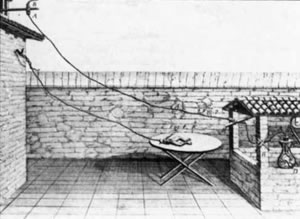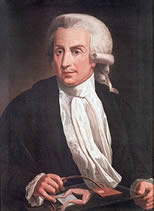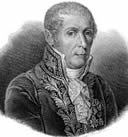Electricity and life – Galvani experiment with frog legs
 Diagram of Galvani's experiment on frog legs
Diagram of Galvani's experiment on frog legs
The beginning of Luigi Galvani's experiments with bio-electricity has a popular legend which says that in 1771, Galvani was slowly skinning a frog at a table where he had been conducting experiments with static electricity by rubbing frog skin. Galvani's assistant touched an exposed sciatic nerve of the frog with a metal scalpel, which had picked up a charge. At that moment, they saw sparks and the dead frog's leg kicked as if in life. The observation made Galvani the first investigator to appreciate the relationship between electricity and animation — or life. This finding provided the basis for the new understanding that the impetus behind muscle movement was electrical energy carried by a liquid (ions), and not air or fluid as in earlier balloonist theories. (Balloonist theory was a theory in early neuroscience that attempted to explain muscle movement by asserting that muscles contract by inflating with air or fluid.)
 Luigi Galvani Italian scientist famous for pioneering bio-electricity
Luigi Galvani Italian scientist famous for pioneering bio-electricity
Galvani coined the term animal electricity to describe the force that activated the muscles of his specimens. This was one of the first forays into the study of bioelectricity, a field that still today studies the electrical patterns and signals of the nervous system.
Luigi Galvani (September 9, 1737 – December 4, 1798) was an Italian physician, physicist and philosopher who had also studied medicine and had practised as a doctor, lived and died in Bologna, in Northern Italy.
Galvani died depressed and in poverty
Galvani actively investigated animal electricity until the end of his life. The Cisalpine Republic, a French client state founded in 1797 after the French occupation of Northern Italy, required every university professor to swear loyalty to the new authority. Galvani, who disagreed with the social and political confusion, refused to swear loyalty, along with other colleagues. This led to the new authority depriving him of all his academic and public positions, which took every financial support away. Galvani died in Bologna, in his brother’s house, depressed and in poverty, on December 4, 1798.
Connect two different metals in series with the frog's leg and make Battery
 Alessandro Giuseppe Antonio Anastasio Volta
Alessandro Giuseppe Antonio Anastasio Volta
Around 1791 Alessandro Volta began to study the "animal electricity" noted by Galvani when two different metals were connected in series with the frog's leg and to one another. He realized that the frog's leg served as both a conductor of electricity (we would now call it an electrolyte) and as a detector of electricity. He replaced the frog's leg by brine-soaked paper, and detected the flow of electricity by other means familiar to him from his previous studies of electricity. In this way he discovered the electrochemical series, and the law that the electromotive force (emf) of a galvanic cell, consisting of a pair of metal electrodes separated by electrolyte, is the difference of their two electrode potentials.